
In Barbara Zaretsky’s world, craft and community flow as one. Pots of dye bubble as visitors and colleagues drop by. Zaretsky studies a wall textile in progress — she’s been eying it for weeks, deciding on the next step. Her studio, Cloth Fiber Workshop, is a textile-education hub; the artist pauses to field a question. Meanwhile, a large piece of fabric is set to dry: one day, it will become four scarves.
In a genre often saturated in zany hues and chunky textures, Zaretsky’s fiber art surprises with its simplicity and grace. She uses natural dyes and fibers, together with the itajime shibori method of tie-dying — a form dating from the 8th century — to make geometric patterns in muted, sophisticated colors: brick, charcoal, mustard, chocolate. Her clientele, many of them contemporary-art collectors and modern-architecture buffs, are lured by the minimalism. Often, they start by buying a wall hanging, adding household items over time. They value Zaretsky’s natural materials, her measured process.

“Some people say this [style] looks Japanese or Danish … there’s a calmness,” says the artist. When she moved to Asheville in 2001, she worked as a graphic designer while pursuing textile projects on the side. By 2007, she opened her studio and the Workshop, but did not leave her graphic-design work completely behind, using the same visual language in her flyers, cards, and online presence.
In the studio, Zaretsky starts with silk, cotton, hemp, or linen, sourced locally and globally. She uses Ahimsa or “peace” silk from India; woven in small villages, it’s processed in a way that the silkworm can emerge and live out its life cycle unharmed. The madder root that makes russet is sourced from Pakistan — but Zaretsky’s yellows come from the spiky weld plants in her own garden and the “gorgeous browns” from the black walnuts in her woods. Then she prepares the fabrics by hand.

The artist says a class at renowned Penland School of Crafts in Spruce Pine was her turning point. “Whatever I was trying to achieve with synthetic dyes and paints I could get more readily [with plant-based pigments], and it was much more satisfying.”
Zaretsky invites national instructors in the rising natural-dye field to lecture in her venue — and she even takes some classes herself. A tempered excitement rises in her voice when she talks about moments of unexpected interaction — the happy accidents — facilitated by using earthen hues. “I took wood from the Osage orange tree; you can get a really great yellow. But when you add ferrous acetate [iron], it turns the perfect shade of green. And the first time that happened — oh my gosh! … Still, every time I see it, I get the same feeling.”
BZDesign and Cloth Fiber Workshop, 191 Lyman St. #101 in the River Arts District. For more information, see bzdesign.biz and clothfiberworkshop.com.